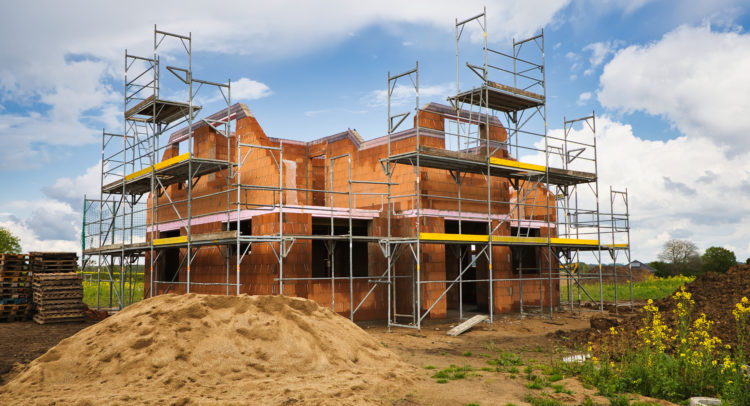The U.S. housing market is locked in a paradox of sorts. Homebuilders have too many unsold properties in hand now, but the U.S. is still suffering from a housing shortage. The only apparent way to bring an equilibrium is for homebuilders to turn inconveniences into opportunities during downturns. If this narrative is anything to go by, two stocks that will be in line to benefit most are Toll Brothers (NYSE:TOL) and DR Horton (NYSE:DHI). The correcting housing market may also provide several upsides to the stocks. Let us see what they are.
Don't Miss Our Christmas Offers:
- Discover the latest stocks recommended by top Wall Street analysts, all in one place with Analyst Top Stocks
- Make smarter investments with weekly expert stock picks from the Smart Investor Newsletter
Build-to-Rent Trend Gathers Steam
The “Pandemic Boom” in the U.S. housing market is about to go bust. High mortgage rates are keeping homebuyers at bay, and there is an oversupply of houses for sale. Also, rents are finally falling back to earth after two years. Experts recall that there is a typical seasonal fall in rental prices during the fall and winter, which means there is more downside for rent left for this year and early 2023. But that is not all that bad for home builders.
The housing stands unaffordable now, and as mortgage rates approach 7%, homebuyers can forget their plans for some more time. When this happens, demand for rental homes is expected to shoot up, leading to higher rental prices once again.
Also, the rising work-from-anywhere flexibility in America is likely to keep the demand for family spaces high. The only other option to have a roof over your head without having to bear elevated home prices and borrowing costs is to rent a property.
All in all, the demand for rental properties is not going to drop so easily, and homebuilders are realizing this quickly. This is why build-for-rent is a growing trend and homebuilders like DR Horton and Toll Brothers are jumping on the bandwagon.
Basically, builders build homes and put them up for rent directly, and not through owners. This way, they can benefit from rising rents as well.
The National Association of Home Builders found that 13,000 new single-family homes hit the market directly as rentals in the first quarter of 2022, up 63% year-over-year.
Improved Infrastructure May Boost Housing Demand
On the other hand, the prime locations for residency in the U.S. are running low on land for new constructions. This is due to hard restrictions on land use and less-than-desirable government investment in public infrastructure so far. Homebuilders have struggled to find land in population-dense locations, and have faced exorbitant prices for the same.
However, the recent Bipartisan Infrastructure Law, which sets aside $110 billion for building new roads, bridges, and other major infrastructure projects, looks promising in that direction. Once the investments start taking effect, the U.S. is expected to see better infrastructure, which will give rise to housing demand in more locations that, right now, are difficult to commute to. This will ultimately help homebuilders procure more land for construction.
Falling Lumber Prices Also Bode Well
When interest rates and housing prices were affordable and demand was high, builders had to wait years to obtain permits. Now, interest rates are high, housing unattainably expensive, and demand is low. But builders are facing the problem of high construction costs.
Homebuilders have another reason to rejoice. Lumber prices have fallen to their lowest level in more than two years. Granted, a slowdown in construction may be one of the reasons behind the decline in lumber prices. But, considering that climbing lumber prices have so far played a key role in pushing up home prices, homebuilders might see a drop in material costs and a boost in margins.
Keeping a far-sighted approach, a drop in lumber prices will bring down home prices too, and help demand recovery for the same. Homebuilders stand to benefit from this too.
Now that we have established that homebuilders still have a few upsides left even in this tricky sector, let us see where DHI and TOL stocks stand.
DR Horton (NYSE:DHI) Stock
Horton is one of the largest builders of high-quality houses, operating for almost 45 years. That means it has survived the 2008 housing market crash.
Recently, while acknowledging that the housing market is cooling down in the face of increased interest rates and inflation, management stated that the company’s affordable product offerings, lot supply, and strong trade and supplier relationships built over four decades will ensure a firm footing during a downturn.
According to Horton CEO David Auld, the average price per house sold by Horton in 2021 is below $350,000, which is around $100,000 lower than its peers. This has enabled Horton to continue gaining market share.
On the rental front, Horton, which is focusing heavily on its multifamily and single‐family rental platforms, expects to rake in $800 million in revenues for the fiscal year of 2022 that ends this month. The builder is also converting some of its for-sale lots into single-family rental spaces.
Will DHI Stock go Up?
Last week, KeyBanc analyst Kenneth Zener upgraded the DHI stock to a Buy from Hold, and kept a price target of $84, which reflects a 23% upside potential.
Moreover, looking at the price-to-earnings (trailing 12-month), DHI’s current valuation of 4.4x is hovering marginally above its 5-year low, making it an attractive stock to buy now.
Wall Street is bullish on the stock, with a Strong Buy consensus rating based on 11 Buys and two Holds. The average price target of $86.67 indicates that the stock can go up by 27.3% over the next 12 months.

Toll Brothers (NYSE:TOL) Stock
Another 2008 housing crash survivor is 34-year-old luxury home builder Toll Brothers. The builder announced around 10 new buildings and communities in various locations in September itself, as the housing market prepares for a severe downturn.
In partnership with build-to-rent company BB Living, Toll Brothers has helped expand the concept by building more than 5,000 rental homes spread across 10 markets nationwide.
Last week, Kenneth Zener upgraded the company to a Hold from Sell, which grabbed investors’ interest.
Raymond James analyst Buck Horne, however, lowered the price target on TOL to $56 from $75, keeping in mind the near-term headwinds and the fact that new home orders are experiencing a steady decline. However, Horne believes that the share prices have already priced in the possibility of a recession. The analyst has a bullish longer-term outlook for the stock, as evidenced by his Buy rating.
Is Toll Brothers a Good Stock to Buy?
Currently, the TOL stock is valued at 4.9x trailing 12-month earnings, which is close to its 5-year lowest valuation of 3.7x recorded in March 2020. This calls for attention to the stock for long-term investors.
Wall Street is cautiously optimistic on TOL, with a Moderate Buy rating, based on four Buys and seven Holds. The average price target is $54, meaning, the prices still have room to grow by 31% over the next 12 months.

Bottom-Line: If DHI and TOL Did it Once, They Can Do It Again
High mortgage rates are causing an economic shock, which is expected to continue to bring the housing market to a correction, causing inventory levels to rise and sales to drop. However, demand for rental homes, a drop in lumber prices, and improved infrastructure create a solid upside for homebuilders like Horton and Toll Brothers to benefit.
Both Horton and Toll Brothers have survived the 2008 crash with their solid experience, strong operating capabilities, and resources. This time too, these stocks appear to be in a position to grow after the turmoil is over.



















